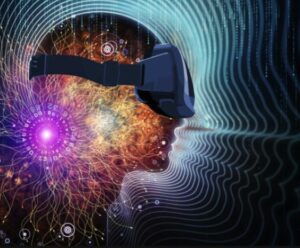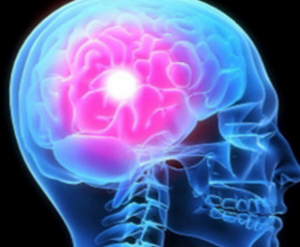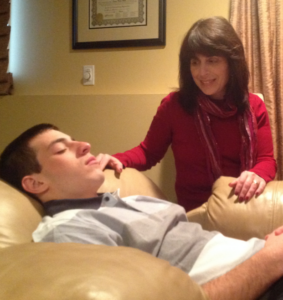 As lawmakers debate on bills that could impact the opioid crisis in Tennessee, people have been looking for alternative treatments to help with chronic pain and, in many cases, addiction.
As lawmakers debate on bills that could impact the opioid crisis in Tennessee, people have been looking for alternative treatments to help with chronic pain and, in many cases, addiction.
Steve Olson has been taking individual and group clinical hypnosis sessions at the Osher Center for Integrative Medicine on West End in Nashville.
Olson has been dealing with neuropathy for the last five years. He described the extreme pain to his thighs as a baseball bat hitting him.
“I cannot even sleep with a bed sheet on my legs because the weight of a bed sheet would be extremely painful, so I would sleep on top of the bed,” Olson told NewsChannel 5. He was active and had a job, but the pain was so unbearable that Olson had to quit and rely on heavy amounts of drugs, including muscle relaxers.
He showed us nearly three pages of medications he had to take. At least one doctor wanted to increase his dosage. “Percocet was seven to eight times a day, and sometimes ten times a day. Morphine was three to four a day. I would basically sit in the chair and stare at the television and sit there and cry for hours,” recalled Olson.
Tennessee is one of the states with the highest number of opioid prescriptions per person, according to the Centers for Disease Control and  Prevention. Alabama, Mississippi, and Arkansas also join the list.
Prevention. Alabama, Mississippi, and Arkansas also join the list.
In January, Governor Bill Haslam proposed an aggressive and comprehensive plan to end the opioid epidemic in the state with three major components, including the legislature addressing prevention by limiting the supply and the dosage of opioid prescriptions.
The 66-year-old Franklin resident even went through at least a dozen doctors and different hospitals for the pain before landing at OCIM.
Dr. Lindsey McKernan helped guide him to a better place and move away from the opioids through hypnosis. “It’s a treatment that focuses between a patient and a provider, and it can be done in a group and an individual setting. It’s about learning a way to relax very deeply where you’re guided into that by a provider,” said McKernan.
She said hypnosis can help reduce the activity of signals firing back and forth between the brain and body when the person is experiencing pain. “It might not be the pain goes completely away, but it could be that your daily pain changes to seven out of ten to five out of ten. That could make the difference between getting out of bed for the day,” added McKernan.
 McKernan emphasized that hypnosis is not what is perceived in Hollywood. It is a method that allows her to relax the brain through “suggestions” and make changes in emotions, mood, thoughts, or how you feel in certain parts of your body. “I think it’s helping me learn to cope with the pain and learn how to live life again,” said Olson.
McKernan emphasized that hypnosis is not what is perceived in Hollywood. It is a method that allows her to relax the brain through “suggestions” and make changes in emotions, mood, thoughts, or how you feel in certain parts of your body. “I think it’s helping me learn to cope with the pain and learn how to live life again,” said Olson.
McKernan started the clinic hypnosis program 18 months ago with a four-hour a week clinic before transitioning to group sessions. The center went from treating four patients to 30 plus every week with a bigger team.
It’s part of research determining the effects of the group program to help with pain and quality of life aspects and how that compares to individual hypnosis. The research will last for another year.
Hypnosis services are covered by most insurances, and if they are done by a trainee under supervision, it is a free service. Most of the clinical services at OCIM are insurance-based, including mindfulness classes. The center’s movement classes (yoga, tai chi), acupuncture, and massage are fee-for-service.
By: Matthew Torres

 Hypnosis has become a common medical tool, used to reduce pain, help people stop smoking and cure them of phobias. But scientists have long argued about whether the hypnotic “trance” is a separate neurophysiological state or simply a product of a hypnotized person’s expectations.
Hypnosis has become a common medical tool, used to reduce pain, help people stop smoking and cure them of phobias. But scientists have long argued about whether the hypnotic “trance” is a separate neurophysiological state or simply a product of a hypnotized person’s expectations.
A study published on Thursday by Stanford researchers offers some evidence for the first explanation, finding that some parts of the brain function differently under hypnosis than during normal consciousness.
The study was conducted with functional magnetic resonance imaging, a scanning method that measures blood flow in the brain. It found changes in activity in brain areas that are thought to be involved in focused attention, the monitoring and control of the body’s functioning, and the awareness and evaluation of a person’s internal and external environments.
“I think we have pretty definitive evidence here that the brain is working differently when a person is in hypnosis,” said Dr. David Spiegel, a professor of psychiatry and behavioral sciences at Stanford who has studied the effectiveness of hypnosis. Functional imaging is a blunt instrument and the findings can be difficult to interpret, especially when a study is looking at activity levels in many brain areas.
professor of psychiatry and behavioral sciences at Stanford who has studied the effectiveness of hypnosis. Functional imaging is a blunt instrument and the findings can be difficult to interpret, especially when a study is looking at activity levels in many brain areas.
Still, Dr. Spiegel said, the findings might help explain the intense absorption, lack of self-consciousness and suggestibility that characterize the hypnotic state.
He said one particularly intriguing finding was that hypnotized subjects showed decreased interaction between a region deep in the brain that is active in self-reflection and daydreaming and areas of the prefrontal cortex involved in planning and executing tasks.
That decreased interaction, Dr. Spiegel said, suggested an explanation for the lack of self-consciousness shown by hypnotized subjects. “That’s why the stage hypnotist can get a football coach to dance like a ballerina without feeling self-conscious about what he’s doing,” Dr. Spiegel said. He added that it might also explain, at least in part, why hypnosis is an effective tool in psychotherapy for getting people to look at a problem in a new way.
 The researchers screened more than 500 potential subjects for susceptibility to hypnosis and then compared brain activity in 36 who scored very highly on tests measuring susceptibility to hypnosis and 21 who had very low scores on those tests.
The researchers screened more than 500 potential subjects for susceptibility to hypnosis and then compared brain activity in 36 who scored very highly on tests measuring susceptibility to hypnosis and 21 who had very low scores on those tests.
Brain activity during hypnosis was also compared with activity during resting periods and during a memory task, for both high and low susceptibility groups.
In the hypnosis task, the subjects were guided through two guided procedures for hypnotic inductions: in one, they were instructed to imagine a time when they felt happiness; in the other, they were told to remember or imagine a vacation.
All the subjects were asked in the study to rate how deeply hypnotized they felt during the inductions. Although some researchers continue to argue that hypnosis is a state produced by people’s expectations, not by biology, Dr. Spiegel said, “At some point, I just think it becomes a kind of self-fulfilling word game. I see hypnosis as a kind of app you haven’t used on your cellphone,” he said. “It’s got all kinds of capacity that people are just figuring out how to use, but if you haven’t used it the phone doesn’t do that.”
By: Erica Goode

 Some argue that hypnosis is just a trick. Others, however, see it as bordering on the paranormal – mysteriously transforming people into mindless robots. Now our recent review of a number of research studies on the topic reveals it is actually neither. Hypnosis may just be an aspect of normal human behavior.
Some argue that hypnosis is just a trick. Others, however, see it as bordering on the paranormal – mysteriously transforming people into mindless robots. Now our recent review of a number of research studies on the topic reveals it is actually neither. Hypnosis may just be an aspect of normal human behavior.
Hypnosis refers to a set of procedures involving an induction – which could be fixating on an object, relaxing or actively imagining something – followed by one or more suggestions, such as “You will be completely unable to feel your left arm”.
The purpose of the induction is to induce a mental state in which participants are focused on instructions from the experimenter or therapist, and are not distracted by everyday concerns. One reason why hypnosis is of interest to scientists is that participants often report that their responses feel automatic or outside their control.
Most inductions produce equivalent effects. But inductions aren’t actually that important. Surprisingly, the success of hypnosis doesn’t rely on special abilities of the hypnotist either – although building rapport with them will certainly be valuable in a therapeutic context.
Rather, the main driver for successful hypnosis is one’s level of “hypnotic suggestibility”. This is a term which describes how responsive we are to suggestions. We know that hypnotic suggestibility doesn’t change over time and is heritable. Scientists have even found that people with certain gene variants are more suggestible.
Most people are moderately responsive to hypnosis. This means they can have vivid changes in behavior and experience in response  to hypnotic suggestions. By contrast, a small percentage (around 10-15%) of people are mostly non-responsive. But most research on hypnosis is focused on another small group (10-15%) who are highly responsive.
to hypnotic suggestions. By contrast, a small percentage (around 10-15%) of people are mostly non-responsive. But most research on hypnosis is focused on another small group (10-15%) who are highly responsive.
In this group, suggestions can be used to disrupt pain, or to produce hallucinations and amnesia. Considerable evidence from brain imaging reveals that these individuals are not just faking or imagining these responses.
Indeed, the brain acts differently when people respond to hypnotic suggestions than when they imagine or voluntarily produce the same responses. Preliminary research has shown that highly suggestible individuals may have unusual functioning and connectivity in the prefrontal cortex.
This is a brain region that plays a critical role in a range of psychological functions including planning and the monitoring of one’s mental states. There is also some evidence that highly suggestible individuals perform more poorly on cognitive tasks known to depend on the prefrontal cortex, such as working memory.
However, these results are complicated by the possibility that there might be different sub types of highly suggestible individuals. These neurocognitive differences may lend insights into how highly suggestible individuals respond to suggestions: they may be more responsive because they’re less aware of the intentions underlying their responses.
 For example, when given a suggestion to not experience pain, they may suppress the pain but not be aware of their intention to do so. This may also explain why they often report that their experience occurred outside their control. Neuroimaging studies have not as yet verified this hypothesis but hypnosis does seem to involve changes in brain regions involved in monitoring of mental states, self-awareness and related functions.
For example, when given a suggestion to not experience pain, they may suppress the pain but not be aware of their intention to do so. This may also explain why they often report that their experience occurred outside their control. Neuroimaging studies have not as yet verified this hypothesis but hypnosis does seem to involve changes in brain regions involved in monitoring of mental states, self-awareness and related functions.
Although the effects of hypnosis may seem unbelievable, it’s now well accepted that beliefs and expectations can dramatically impact human perception. It’s actually quite similar to the placebo response, in which an ineffective drug or therapeutic treatment is beneficial purely because we believe it will work. In this light, perhaps hypnosis isn’t so bizarre after all. Seemingly sensational responses to hypnosis may just be striking instances of the powers of suggestion and beliefs to shape our perception and behavior. What we think will happen morphs seamlessly into what we ultimately experience.
Hypnosis requires the consent of the participant or patient. You cannot be hypnotized against your will and, despite popular misconceptions, there is no evidence that hypnosis could be used to make you commit immoral acts against your will.
Hypnosis as medical treatment
Meta-analyses, studies that integrate data from many studies on a specific topic, have shown that hypnosis works quite well when it comes to treating certain conditions. These include irritable bowel syndrome and chronic pain. But for other conditions, however, such as smoking, anxiety, or post-traumatic stress disorder, the evidence is less clear cut – often because there is a lack of reliable research.
But although hypnosis can be valuable for certain conditions and symptoms, it’s not a panacea. Anyone considering seeking hypnotherapy should do so only in consultation with a trained professional. Unfortunately, in some countries, including the UK, anyone can legally present themselves as a hypnotherapist and start treating clients. However, anyone using hypnosis in a clinical or therapeutic context needs to have conventional training in a relevant discipline, such as clinical psychology, medicine, or dentistry to ensure that they are sufficiently expert in that specific area.
should do so only in consultation with a trained professional. Unfortunately, in some countries, including the UK, anyone can legally present themselves as a hypnotherapist and start treating clients. However, anyone using hypnosis in a clinical or therapeutic context needs to have conventional training in a relevant discipline, such as clinical psychology, medicine, or dentistry to ensure that they are sufficiently expert in that specific area.
We believe that hypnosis probably arises through a complex interaction of neurophysiological and psychological factors – some described here and others unknown. It also seems that these vary across individuals.
But as researchers gradually learn more, it has become clear that this captivating phenomenon has the potential to reveal unique insights into how the human mind works. This includes fundamental aspects of human nature, such as how our beliefs affect our perception of the world and how we come to experience control over our actions.
By: Devin Terhune and Steven Jay Lynn

 Virtual reality hypnosis (VRH) can reduce the need for postoperative opioids and anti-anxiety medications and lead to improved outcomes in children, new research suggests.
Virtual reality hypnosis (VRH) can reduce the need for postoperative opioids and anti-anxiety medications and lead to improved outcomes in children, new research suggests.
A team of anesthesiologists at the University of Texas Southwestern Medical Center and Hopitaux Universitaires de Strasbourg in France studied 21 children undergoing surgery for scoliosis, comparing 10 who received VRH in addition to the usual postoperative pain management to 11 children who did not receive VRH.
They found that the VRH group had significantly lower need for supplemental treatment for anxiety, opioid analgesics, and less incidence of vomiting as well as shorter time to urinary catheter removal and shorter time to getting up.
“Nonpharmacological approaches should play a critical role in treatment of perioperative anxiety and pain,” corresponding author Girish P. Joshi, MD, professor of anesthesiology and pain management, University of Texas Southwestern Medical Center, Dallas, told Medscape Medical News.
“This can be achieved through several approaches, including appropriate/adequate education and discussion, as well as use of novel technology,” he said. The study was presented at Anesthesiology 2018, the annual meeting of the American Society of Anesthesiologists in San Francisco.
Encouraging Findings
“Hypnosis and virtual reality (VR) have been shown to influence anxiety and chronic pain, but its role in acute pain, particularly in children, was not assessed previously,” Joshi said.
The aim of the current retrospective study was to evaluate the effects of VRH support on postoperative pain and opioids use in children undergoing scoliosis surgery.
From May 2017 onward, VRH support was added to the usual postoperative pain management in all pediatric patients, with a VRH session performed daily for 20 minutes during the first 72-hour postoperative period.
The control group consisted of children who had undergone the same procedure without VRH support before May 2017 and were demographically similar to the VRH group.
The researchers collected data regarding maximum postoperative pain scores per day, the total opioid dose, the number of postoperative vomiting episodes, request for supplemental treatment for pain and/or anxiety, time to oral intake, time to urinary catheter removal, time to getting up, and hospital length of stay.
The VRH group experienced several significant advantages over the control group:
- Only 20% of the VRH group required opioid medication, compared with 62.5% of the control group (P = .15)
- Only 37.5% of the VRH group required anti-anxiety medication, compared with 100% of the control group (P = .04)
 Total postoperative morphine consumption over the 72-hour period was almost twice as high in the control group vs the VRH group (2.15 mg/kg [1.11] vs 1.18 mg/kg [0.28] P = .015)
Total postoperative morphine consumption over the 72-hour period was almost twice as high in the control group vs the VRH group (2.15 mg/kg [1.11] vs 1.18 mg/kg [0.28] P = .015)- VRH group members were able to get up more quickly after surgery, compared to the control group (23 hours [3] vs 44 hours [16.02] P = 0.004)
- The VRH group experienced less postoperative vomiting, compared to the control group (40% vs 83.33%, P = .15)
- Time to catheter removal in the control group was twice that of the VRH group (40.95 hours [18.1] vs 20.14 hours [8.9] P = .03)
- There was no significant difference in average length of stay between the control and the VRH groups (137.7 hours vs 125.5 hours).
- “To our knowledge, this is the first study assessing the postoperative use of VRH in children,” the authors write. “These findings of this pilot study are encouraging.”
- Joshi emphasized that before this technology can be implemented in current routine clinical practice, more prospective, randomized controlled trials that are “adequately powered” are needed.
- Creative, Useful
- Commenting on the study for Medscape Medical News, David Spiegel, MD, Willson Professor in Medicine and Associate Chair of Psychiatry at Stanford University in California, said that although it was not a controlled trial, it was nevertheless “very compelling” and described VRH as “a very creative and useful technique.”
- “Particularly notable is that the children given the VRH used half the opioid dose,” pointed out Spiegel, who was not involved with the study.
- “These days, 133 people per day in the US are dying of opioid overdoses and the longer you stay on them [opioids] the more likely you are to become addicted, especially
 since these are children and not adults.”
since these are children and not adults.”
- “So anything that can reduce opioid consumption — both the amount and the length — is protective, and one way to look at VRH is that it seems to help and it sure doesn’t hurt,” he added.
- Spiegel noted that, as a group, children are more easily hypnotized than adults.
- He referenced a study that he and four colleagues conductedin 2005, in which children undergoing voiding cystourethrography, an invasive and painful procedure involving insertion of contrast dye into the bladder, were randomized to 2 groups: half received routine care, including hospital-provided recreation, while the other half received a hypnosis intervention.
- “We were able to reduce pain and distress and shorten the procedure time by 17 minutes in the hypnosis group,” he reported.
- The current study is “consistent with these findings, and the combination of VRH is interesting since VR helps to do technologically what one does phenomenologically in hypnosis — in other words, narrowing the focus of attention.”
- He hopes that the VRH study “sets a precedent for support like this for children routinely when they undergo procedures like this.”
- Joshi added that the Strasbourg group is contemplating a prospective study.
- “We are hoping other groups will also embark upon research similar to ours,” Joshi said.
- No source of funding for the discussed VRH study was disclosed by its authors in the original article. Joshi, study coauthors, and Spiegel have disclosed no relevant financial relationships.
- Anesthesiology 2018 from the American Society of Anesthesiologists: Abstract Presented October 14, 2018.
- For more from Medscape Neurology, join us on Twitter and Facebook
By: Batya Swift Yasgur, MA, LSW

 When “Comedy Hypnotist” Chris Jones invited celebrity judge Howie Mandel on stage and hypnotized him on the competition show “America’s Got Talent,” the performance brought the audience to its feet and even inspired a social media hashtag, #HowieShakesHands.
When “Comedy Hypnotist” Chris Jones invited celebrity judge Howie Mandel on stage and hypnotized him on the competition show “America’s Got Talent,” the performance brought the audience to its feet and even inspired a social media hashtag, #HowieShakesHands.
Mandel, who struggles with obsessive compulsive disorder, followed Jones’ cues and for the first time in more than eight years, the germaphobe shook hands with his fellow judges. The seemingly instant transformation was so surprising, some viewers thought it was an act, Mandel said it was not.
But according to David Spiegel, professor of psychiatry and behavioral sciences at Stanford University, not only is hypnotherapy legitimate, it’s “literally the old est Western conception of a psychotherapy.”
Moreover, Wesley Anderson, a practicing hypnotherapist for more than 20 years, said, “Most people experience some form of a hypnotic state every day.” “If you’ve ever been lost in a daydream or zoned out and missed your turn while driving your usual route, you’ve experienced a form of hypnosis,” he said.
Does it really work?
Spiegel has been conducting studies about the benefits of hypnosis for more than 40 years and he said there is no doubt that hypnosis works as an effective therapeutic technique to manage pain and kick bad habits.
In 2000, Spiegel and his colleagues determined that patients using hypnosis as a part of a comprehensive treatment plan could significantly reduce drug use and procedure time.
“Lowering those two meant an average cost savings of approximately $338,” Spiegel said.
A 2007 article in the Journal of the National Cancer Institute doubled that figure, finding that a hospital saved $772 per patient in the hypnosis group, mainly due to reduced surgical time. “Patients who received hypnosis reported less post-surgical pain, nausea, fatigue and discomfort,” according to a release from the American Psychological Association.
“Patients who received hypnosis reported less post-surgical pain, nausea, fatigue and discomfort,” according to a release from the American Psychological Association.
Hypnosis has its skeptics, partly because while studies seem to show it has tangible benefits, it’s most often used in tandem with other treatments; scientifically quantifying its success alone is difficult. From comedy performers such as Jones to Harvard educated psychiatrists such as Spiegel, anyone can learn to hypnotize and call themselves a “hypnotist,” which also gives doubters pause.
Three states — Colorado, Connecticut and Washington — require mandatory licensing requirements from individuals wanting to practice hypnotherapy.
According to the American Society of Clinical Hypnosis, or ASCH, most insurance companies will cover 50% to 80% of the cost of individual therapy, but only if treated by licensed professionals. ASCH requires its members to be licensed health care workers and, at minimum, have a master’s degree.
The National Board for Certified Clinical Hypnotherapists, on the other hand, requires applicants have a graduate-level degree as well as 50 hours of classroom instruction and 30 hours of clinical training.
How does it work?
The first thing Anderson does when meeting a new client is what anyone would do upon meeting a stranger: He gets to know them. “I try to establish a rapport and establish the client’s intentions for hypnosis,” Anderson said.
Using verbal and nonverbal cues, a hypnotherapist will help the client quiet their peripheral, conscious mind, the part that’s constantly stimulated by outside sources. Clients will relax, their posture will adjust and they will usually become very still, Anderson said. “They’re halfway between being completely asleep and completely awake,” he explained.
In this trance-like state, the part of the brain responsible for the subconscious, non-logical thoughts can become wide open to suggestions. “The normal adult filters and belief systems of what is and what isn’t will start to fade,” he said. “Clients become almost childlike.” Hypnotherapists can then begin to use imagery and suggestion to help them start thinking about their bad habits or their pain differently.
 For radio host Jenn Hobby, who underwent hypnosis to help her kick her smoking habit, that meant tapping into her relationship with her goddaughter, who at the time of her session, was just a toddler. Her hypnotherapist told her to imagine her goddaughter playing outside and running around the playground.
For radio host Jenn Hobby, who underwent hypnosis to help her kick her smoking habit, that meant tapping into her relationship with her goddaughter, who at the time of her session, was just a toddler. Her hypnotherapist told her to imagine her goddaughter playing outside and running around the playground.
“Then he said, ‘now imagine giving her a lit cigarette,'” Hobby remembers. “That really hit home, more than anything else.” When she left the office that day, she felt differently about cigarettes and smoking. Helping clients manage pain, Anderson said, he often counsels them to turn down receptors that might cause them discomfort the same way a plumber might turn off water before working to repair a leak.
“The pain signals might be there, but they wouldn’t make it into awareness,” Anderson said. Feeling ‘somewhat betrayed’ What’s vital to the process, Anderson and Spiegel said, is that both parties — hypnotherapist and client — agree to the intentions of the session beforehand. Mandel said he agreed to participate in the segment and said he knew what he was doing the entire time, but he never established a rapport with his hypnotist.
So while his “handshaking breakthrough” seemed like a positive thing, for Mandel, the former “Deal or No Deal” host said he felt “somewhat betrayed” after he watched the episode. “I was upset about it and it’s hard for me to watch,” Mandel told NBC’s Savannah Guthrie.
Spiegel said Mandel’s reaction to his experience is understandable. “When entertainers with no knowledge or concern for clinical care take advantage of a real phenomenon, real people can feel exposed, tricked or humiliated,” he said.
Only one part of the puzzle
Despite the success of Hobby’s hypnosis experience — she’s only had a few cigarettes since — she said being hypnotized wasn’t the only thing that led to her quitting. ”
There’s no magic pill. You have to be really committed to change your behavior,” she said. Spiegel agreed. Hypnosis, while valuable, is only one part of the comprehensive treatment puzzle. “Anything that can help a patient that much is worth looking into,” he said.
By: Stephanie Gallman, CNN
New research shows that hypnosedation is a valuable alternative to conventional general anesthesia. is a technique which combines hypnosis, conscious sedation (where drugs are used to make the patient comfortable and relaxed while remaining conscious), and local anesthesia to block pain.
 It has previously been shown to decrease the need for medication, reduce adverse effects, and to accelerate postoperative rehabilitation when compared to general anesthesia in which the patient is rendered unconscious.
It has previously been shown to decrease the need for medication, reduce adverse effects, and to accelerate postoperative rehabilitation when compared to general anesthesia in which the patient is rendered unconscious.
This research team led by Dr Aurore Marcou and colleagues from the Institut Curie, Paris, France, say: “By minimizing effects of anesthesia on vital functions while preserving the patients’ well-being, it contributes to a sustainable development of anesthesia.”
The authors performed a retrospective study of 150 cancer patients who were treated at the Institute Curie between 2011 and 2017, and whose operations were performed under hypnosis. Procedures were conducted with the usual safety conditions and monitoring in place, however they excluded all premedication or hypnotic drugs.
A continuous supply of the opioid remifentanil was given during each operation to keep the patients comfortable, and they were provided with the usual anti-sickness drugs and a painkiller as a preventative measure. Local or regional anesthesia was performed depending on the type and location of surgery, but the patient remained conscious throughout the procedure.
Hypnosedation was used in breast surgeries (including total mastectomies), which represented 90% of the surgeries in this study, and also gynecological surgeries, colonoscopies, and superficial plastic surgeries (representing 10% between them).
The mean duration of procedures was 60 minutes (30 to 160 minutes), and the mean length of stay in the recovery room was 35 minutes. Patients were aged from 18 to 100 years with a mean of 60.5 years, with 22% older than 75 years.
Individuals were grouped according to the severity of their condition, with 2% being classified as having severe cardiac, respiratory, or renal failures that seriously questioned the benefit of using traditional general anesthesia.
The authors found that in 99% of cases, hypnosedation provided comfortable conditions for both the patient and the surgeon operating on them. Patient discomfort happened in just two cases, and in both of these, general anesthesia was quickly and easily implemented.
The authors conclude that: “Hypnosedation can be proposed as a useful alternative to general anesthesia in various types of surgeries including major breast surgeries. By minimizing effects of anesthesia, this technique is particularly valuable for vulnerable patients. Hypnosis benefits the patient as well as the caregivers.”
News-Medical.net June 2018
 As lawmakers debate on bills that could impact the opioid crisis in Tennessee, people have been looking for alternative treatments to help with chronic pain and, in many cases, addiction.
As lawmakers debate on bills that could impact the opioid crisis in Tennessee, people have been looking for alternative treatments to help with chronic pain and, in many cases, addiction. Prevention. Alabama, Mississippi, and Arkansas also join the list.
Prevention. Alabama, Mississippi, and Arkansas also join the list. McKernan emphasized that hypnosis is not what is perceived in Hollywood. It is a method that allows her to relax the brain through “suggestions” and make changes in emotions, mood, thoughts, or how you feel in certain parts of your body. “I think it’s helping me learn to cope with the pain and learn how to live life again,” said Olson.
McKernan emphasized that hypnosis is not what is perceived in Hollywood. It is a method that allows her to relax the brain through “suggestions” and make changes in emotions, mood, thoughts, or how you feel in certain parts of your body. “I think it’s helping me learn to cope with the pain and learn how to live life again,” said Olson.

 Hypnosis has become a common medical tool, used to reduce pain, help people stop smoking and cure them of phobias. But scientists have long argued about whether the hypnotic “trance” is a separate neurophysiological state or simply a product of a hypnotized person’s expectations.
Hypnosis has become a common medical tool, used to reduce pain, help people stop smoking and cure them of phobias. But scientists have long argued about whether the hypnotic “trance” is a separate neurophysiological state or simply a product of a hypnotized person’s expectations. professor of psychiatry and behavioral sciences at Stanford who has studied the effectiveness of hypnosis. Functional imaging is a blunt instrument and the findings can be difficult to interpret, especially when a study is looking at activity levels in many brain areas.
professor of psychiatry and behavioral sciences at Stanford who has studied the effectiveness of hypnosis. Functional imaging is a blunt instrument and the findings can be difficult to interpret, especially when a study is looking at activity levels in many brain areas. The researchers screened more than 500 potential subjects for susceptibility to hypnosis and then compared brain activity in 36 who scored very highly on tests measuring susceptibility to hypnosis and 21 who had very low scores on those tests.
The researchers screened more than 500 potential subjects for susceptibility to hypnosis and then compared brain activity in 36 who scored very highly on tests measuring susceptibility to hypnosis and 21 who had very low scores on those tests.
 Some argue that hypnosis is just a trick. Others, however, see it as bordering on the paranormal – mysteriously transforming people into mindless robots. Now our recent review of a number of research studies on the topic reveals it is actually neither. Hypnosis may just be an aspect of normal human behavior.
Some argue that hypnosis is just a trick. Others, however, see it as bordering on the paranormal – mysteriously transforming people into mindless robots. Now our recent review of a number of research studies on the topic reveals it is actually neither. Hypnosis may just be an aspect of normal human behavior. to hypnotic suggestions. By contrast, a small percentage (around 10-15%) of people are mostly non-responsive. But most research on hypnosis is focused on another small group (10-15%) who are highly responsive.
to hypnotic suggestions. By contrast, a small percentage (around 10-15%) of people are mostly non-responsive. But most research on hypnosis is focused on another small group (10-15%) who are highly responsive. For example, when given a suggestion to not experience pain, they may suppress the pain but not be aware of their intention to do so. This may also explain why they often report that their experience occurred outside their control. Neuroimaging studies have not as yet verified this hypothesis but hypnosis does seem to involve changes in brain regions involved in monitoring of mental states, self-awareness and related functions.
For example, when given a suggestion to not experience pain, they may suppress the pain but not be aware of their intention to do so. This may also explain why they often report that their experience occurred outside their control. Neuroimaging studies have not as yet verified this hypothesis but hypnosis does seem to involve changes in brain regions involved in monitoring of mental states, self-awareness and related functions. should do so only in consultation with a trained professional. Unfortunately, in some countries, including the UK, anyone can legally present themselves as a hypnotherapist and start treating clients. However, anyone using hypnosis in a clinical or therapeutic context needs to have conventional training in a relevant discipline, such as clinical psychology, medicine, or dentistry to ensure that they are sufficiently expert in that specific area.
should do so only in consultation with a trained professional. Unfortunately, in some countries, including the UK, anyone can legally present themselves as a hypnotherapist and start treating clients. However, anyone using hypnosis in a clinical or therapeutic context needs to have conventional training in a relevant discipline, such as clinical psychology, medicine, or dentistry to ensure that they are sufficiently expert in that specific area.

 Total postoperative
Total postoperative 
 When “Comedy Hypnotist” Chris Jones invited celebrity judge Howie Mandel on stage and hypnotized him on the competition show “America’s Got Talent,” the performance brought the audience to its feet and even inspired a social media hashtag, #HowieShakesHands.
When “Comedy Hypnotist” Chris Jones invited celebrity judge Howie Mandel on stage and hypnotized him on the competition show “America’s Got Talent,” the performance brought the audience to its feet and even inspired a social media hashtag, #HowieShakesHands. For radio host Jenn Hobby, who underwent hypnosis to help her kick her smoking habit, that meant tapping into her relationship with her goddaughter, who at the time of her session, was just a toddler. Her hypnotherapist told her to imagine her goddaughter playing outside and running around the playground.
For radio host Jenn Hobby, who underwent hypnosis to help her kick her smoking habit, that meant tapping into her relationship with her goddaughter, who at the time of her session, was just a toddler. Her hypnotherapist told her to imagine her goddaughter playing outside and running around the playground. It has previously been shown to decrease the need for medication, reduce adverse effects, and to accelerate postoperative rehabilitation when compared to general anesthesia in which the patient is rendered unconscious.
It has previously been shown to decrease the need for medication, reduce adverse effects, and to accelerate postoperative rehabilitation when compared to general anesthesia in which the patient is rendered unconscious.







